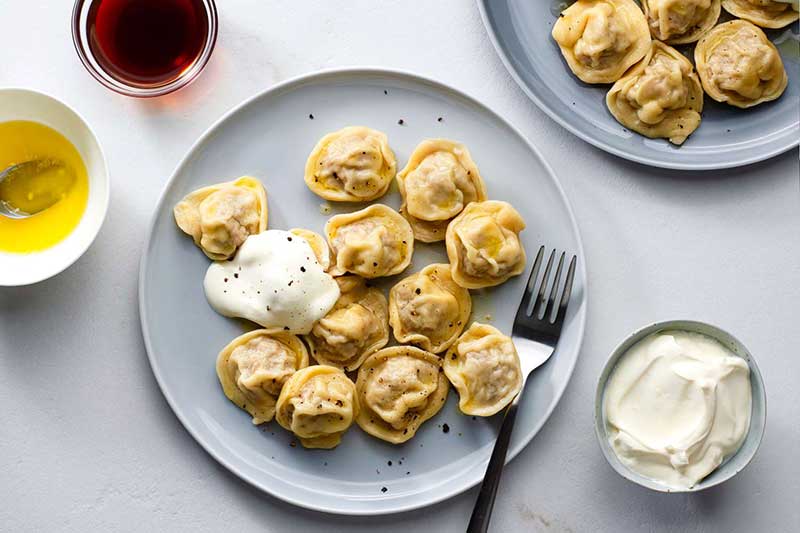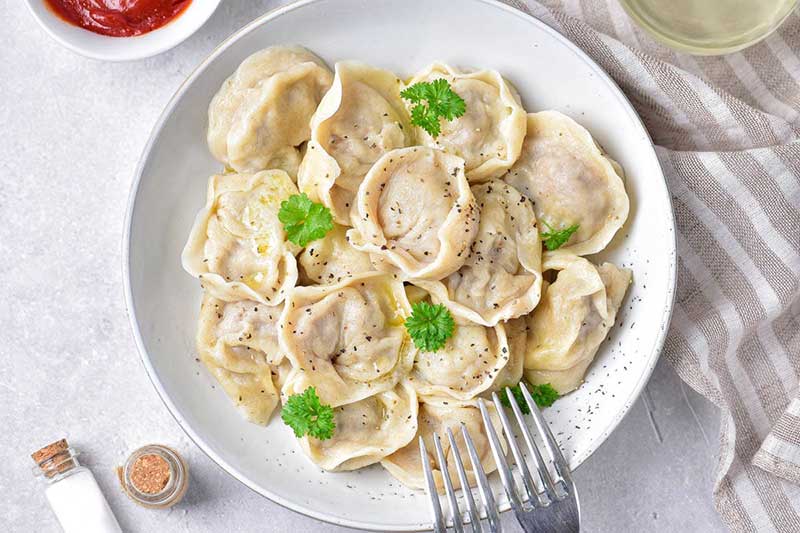 Russian cuisine is renowned for its rich flavors and hearty dishes. One beloved traditional dish that has stood the test of time is classic Russian dumplings. These delectable delights are known as “pelmeni” in Russian and have been enjoyed by generations. In this article, vauro will delve into the world of classic Russian dumplings, exploring their history, authentic recipes, and offering valuable tips to make your dumpling experience truly unforgettable.
Russian cuisine is renowned for its rich flavors and hearty dishes. One beloved traditional dish that has stood the test of time is classic Russian dumplings. These delectable delights are known as “pelmeni” in Russian and have been enjoyed by generations. In this article, vauro will delve into the world of classic Russian dumplings, exploring their history, authentic recipes, and offering valuable tips to make your dumpling experience truly unforgettable.
Introduction: Exploring the World of Russian Dumplings
Russian dumplings, or pelmeni, have been a staple in Russian households for centuries. These small pockets of joy are typically filled with a mixture of ground meat, onions, and spices, encased in a thin dough. The dumplings are then boiled, steamed, or pan-fried to perfection. Russian families often gather together to make pelmeni as a social and culinary tradition, passing down recipes and techniques from one generation to the next.The History and Significance of Pelmeni
Pelmeni have a fascinating history that dates back to the 13th century. It is believed that Mongol warriors introduced the concept of filled dumplings to the Russian region during their invasions. Over time, the dish evolved, and Russian culinary traditions molded it into what we know today as pelmeni. These dumplings became popular due to their long shelf life, making them a convenient food source during long winters in remote areas.Ingredients: Building Blocks of Flavor
To create authentic Russian dumplings, you will need a few key ingredients. The dough is typically made from flour, water, and a pinch of salt. The filling traditionally consists of ground beef, pork, and onions, seasoned with salt, pepper, and various herbs. However, you can also find alternative fillings, such as lamb, chicken, or mushroom, depending on your preferences.
Step-by-Step Recipe: Crafting Perfect Russian Dumplings
Making the Dough
- In a large mixing bowl, combine the flour and salt.
- Gradually add water to the flour mixture while stirring with a wooden spoon.
- Continue to mix until the dough forms a ball.
- Knead the dough on a lightly floured surface until it becomes smooth and elastic.
- Wrap the dough in plastic wrap and let it rest for 30 minutes.
Preparing the Filling
- In a bowl, mix together the ground meat, finely chopped onions, salt, pepper, and desired herbs.
- Use your hands to thoroughly combine the ingredients until the mixture is well incorporated.
Assembling the Dumplings
- Roll out the dough to a thin, even sheet.
- Use a round cookie cutter or a glass to cut out circles from the dough.
- Place a small amount of the meat filling in the center of each dough circle.
- Fold the dough in half, sealing the edges together by pressing firmly.
- Continue this process until all the dough circles are filled.
Cooking the Dumplings
- Bring a large pot of salted water to a boil.
- Gently drop the dumplings into the boiling water and cook for about 4-5 minutes or until they float to the surface.
- Using a slotted spoon, remove the cooked dumplings from the water and transfer them to a serving dish.
Cooking Techniques: Boiling, Steaming, or Pan-Frying?
Russian dumplings can be cooked using various techniques, each offering a unique flavor and texture. Boiling is the most common method, ensuring a tender and juicy filling. Steaming the dumplings produces a lighter result, while pan-frying creates a delightful crispy exterior. Experiment with different cooking methods to find your preferred style.Serving Suggestions: Sauces, Condiments, and Garnishes
Russian dumplings are traditionally served with a variety of accompaniments. Sour cream is a popular choice, adding a creamy and tangy element to the dish. You can also serve pelmeni with melted butter, vinegar, or soy sauce for an alternative flavor profile. Garnish your dumplings with fresh herbs like dill or parsley to enhance the visual appeal and provide a burst of freshness.Discover the Authentic Chongqing Xiaomian
Traditional Dumpling Variations from Different Russian Regions
As with many traditional dishes, Russian dumplings have regional variations that reflect local flavors and preferences. For example, Siberian pelmeni often feature a mix of meats like beef, lamb, and pork. In the Urals region, you might find pelmeni made with fish or game meat. Exploring these regional variations can introduce you to a diverse range of flavors within the world of Russian dumplings.Tips for Perfecting Your Dumpling-Making Skills
Crafting the perfect Russian dumplings requires practice and attention to detail. Here are some valuable tips to help you hone your dumpling-making skills:- Ensure the dough is rolled thin but not too thin to prevent the filling from leaking.
- Use a well-seasoned filling to enhance the flavor of the dumplings.
- Seal the dumplings tightly to prevent them from opening during cooking.
- Freeze the dumplings for a few hours before cooking to maintain their shape and prevent sticking.
- Cook the dumplings in small batches to avoid overcrowding the pot and ensure even cooking.
Common Mistakes to Avoid
While making Russian dumplings is a delightful culinary adventure, it’s essential to avoid common pitfalls. Here are some mistakes to steer clear of:- Overstuffing the dumplings, which can cause them to burst open during cooking.
- Using a dry or tough filling that lacks flavor and moisture.
- Failing to seal the edges properly, resulting in the filling leaking out.
- Boiling the dumplings for too long, leading to an overcooked and mushy texture.
- Skipping the resting time for the dough, which helps achieve the desired elasticity.
Frequently Asked Questions (FAQs)
Are Russian dumplings the same as Chinese dumplings?
While both Russian dumplings and Chinese dumplings share similarities in their concept of filled dough, they differ in terms of ingredients, flavors, and cooking methods. Russian dumplings, or pelmeni, have a meat-based filling and are typically boiled or steamed, while Chinese dumplings can have a variety of fillings, including vegetables and seafood, and are often boiled or pan-fried.Can I freeze the dumplings for later use?
Yes, Russian dumplings can be frozen for later use. After assembling the dumplings, place them on a baking sheet lined with parchment paper and freeze until firm. Once frozen, transfer them to a resealable bag or container. Frozen dumplings can be stored for up to three months. When ready to cook, there’s no need to thaw them; simply add them directly to boiling water or a steamer and adjust the cooking time accordingly.What is the best way to reheat leftover dumplings?
To reheat leftover Russian dumplings, it’s best to steam or pan-fry them. Steaming helps retain moisture and prevents them from becoming dry. Place the dumplings in a steamer and steam for 5-7 minutes until heated through. Alternatively, you can pan-fry the dumplings in a bit of oil over medium heat until they develop a crispy exterior and are heated throughout.Are there vegetarian options for Russian dumplings?
Yes, there are vegetarian options available for Russian dumplings. You can substitute the meat filling with a combination of vegetables, such as mushrooms, spinach, or cabbage. Adding flavorful seasonings and herbs will ensure a delicious vegetarian alternative.Can I make dumplings without a pasta machine?
Absolutely! While a pasta machine can make the process more efficient, you can still make Russian dumplings without one. Roll out the dough using a rolling pin until it reaches the desired thickness. Cut out circles using a round cookie cutter or a glass, and proceed with filling and shaping as mentioned in the recipe.Is Shuba Salad a Traditional Russian Dish?
Shuba salad, also known as Russian herring salad, is indeed a traditional Russian dish. This flavorful salad layers boiled potatoes, beets, and carrots, marinated herring, onions, and mayonnaise. The name shuba means fur coat in Russian, alluding to its layered appearance. To prepare this delicious russian herring salad recipe, follow the traditional method passed down through generations.
